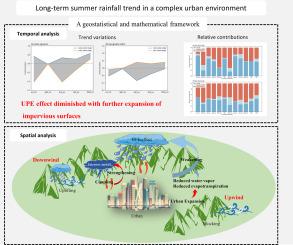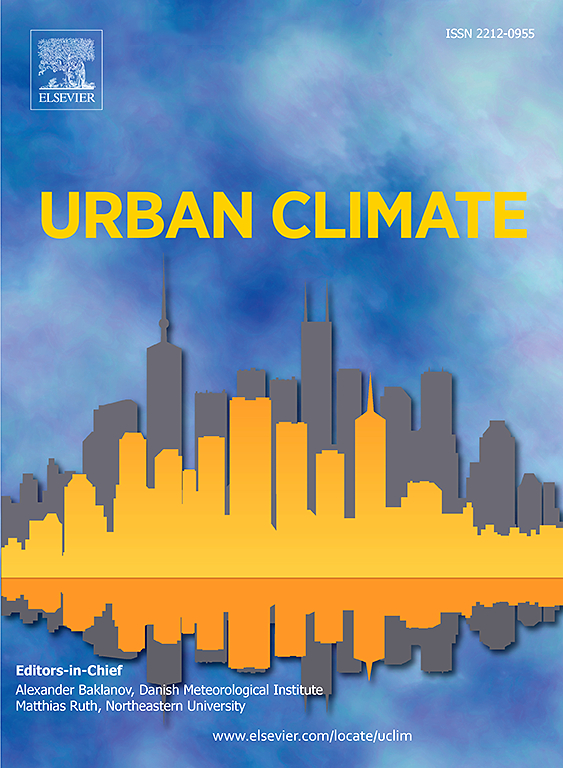Detecting topographic effect and urban signature in long-term summer rainfall trend in a complex urban environment
IF 6
2区 工程技术
Q1 ENVIRONMENTAL SCIENCES
引用次数: 0
Abstract
The influence of topography and urbanization on long-term summer rainfall trends in a complex urban environment is poorly understood. In this study, we utilized high-resolution gridding data (CN05.1) from 2416 long-term station observations (1960–2022) to investigate such influences over Wuhan, China. A geostatistical and mathematical framework was proposed to identify topographic and urban rainfall modifications in complex urban environments. The findings indicated that the topographic effect influences the region by causing it to experience drier conditions in dry years and wetter conditions in wet years, as well as increasing the frequency of light rainfall. Urbanization slightly suppressed light rainfall but amplified the intensity of other forms of rainfall, especially extreme rainfall. As impervious surfaces expanded, the urban precipitation-enhancing (UPE) effect diminished in the later stages of urbanization, particularly in urban and upwind areas, due to factors such as reduced evaporation (ET) and decreased relative humidity (RH). The relative contribution of urbanization to long-term rainfall trends was enhanced as urbanization increased, with increases ranging from 7 % to 40 %. This study demonstrates the potential of geostatistical and mathematical analysis techniques in elucidating the contributions of topography and urbanization to long-term rainfall patterns, leading to a better understanding of rainfall anomalies in complex urban environments.

探测复杂城市环境中长期夏季降雨趋势的地形效应和城市特征
在复杂的城市环境中,地形和城市化对夏季降雨长期趋势的影响尚不清楚。在本研究中,我们利用来自 2416 个长期观测站(1960-2022 年)的高分辨率网格数据(CN05.1)来研究中国武汉地区的此类影响。我们提出了一个地质统计和数学框架来识别复杂城市环境中的地形和城市降雨变化。研究结果表明,地形效应对该地区的影响是使其在干旱年份经历较干燥的条件,在潮湿年份经历较潮湿的条件,以及增加小雨的频率。城市化略微抑制了小雨,但扩大了其他形式降雨的强度,尤其是极端降雨。随着不透水表面的扩大,城市降水增强效应在城市化后期逐渐减弱,特别是在城市和上风地区,这是由于蒸发量(ET)减少和相对湿度(RH)降低等因素造成的。城市化对长期降雨趋势的相对贡献随着城市化程度的提高而增强,增幅从 7% 到 40% 不等。这项研究证明了地质统计和数学分析技术在阐明地形和城市化对长期降雨模式的影响方面的潜力,有助于更好地理解复杂城市环境中的降雨异常现象。
本文章由计算机程序翻译,如有差异,请以英文原文为准。
求助全文
约1分钟内获得全文
求助全文
来源期刊

Urban Climate
Social Sciences-Urban Studies
CiteScore
9.70
自引率
9.40%
发文量
286
期刊介绍:
Urban Climate serves the scientific and decision making communities with the publication of research on theory, science and applications relevant to understanding urban climatic conditions and change in relation to their geography and to demographic, socioeconomic, institutional, technological and environmental dynamics and global change. Targeted towards both disciplinary and interdisciplinary audiences, this journal publishes original research papers, comprehensive review articles, book reviews, and short communications on topics including, but not limited to, the following:
Urban meteorology and climate[...]
Urban environmental pollution[...]
Adaptation to global change[...]
Urban economic and social issues[...]
Research Approaches[...]
 求助内容:
求助内容: 应助结果提醒方式:
应助结果提醒方式:


